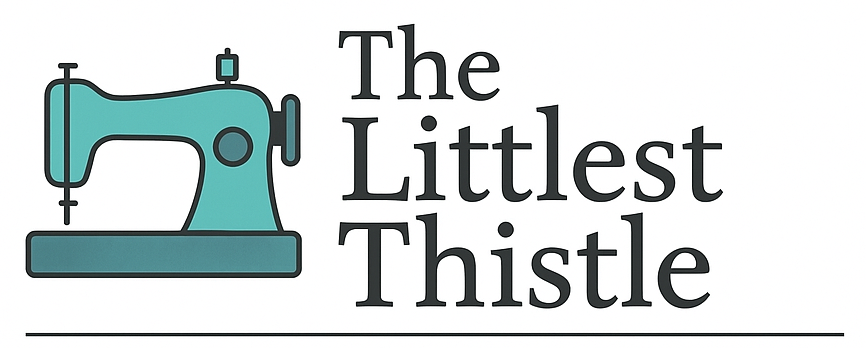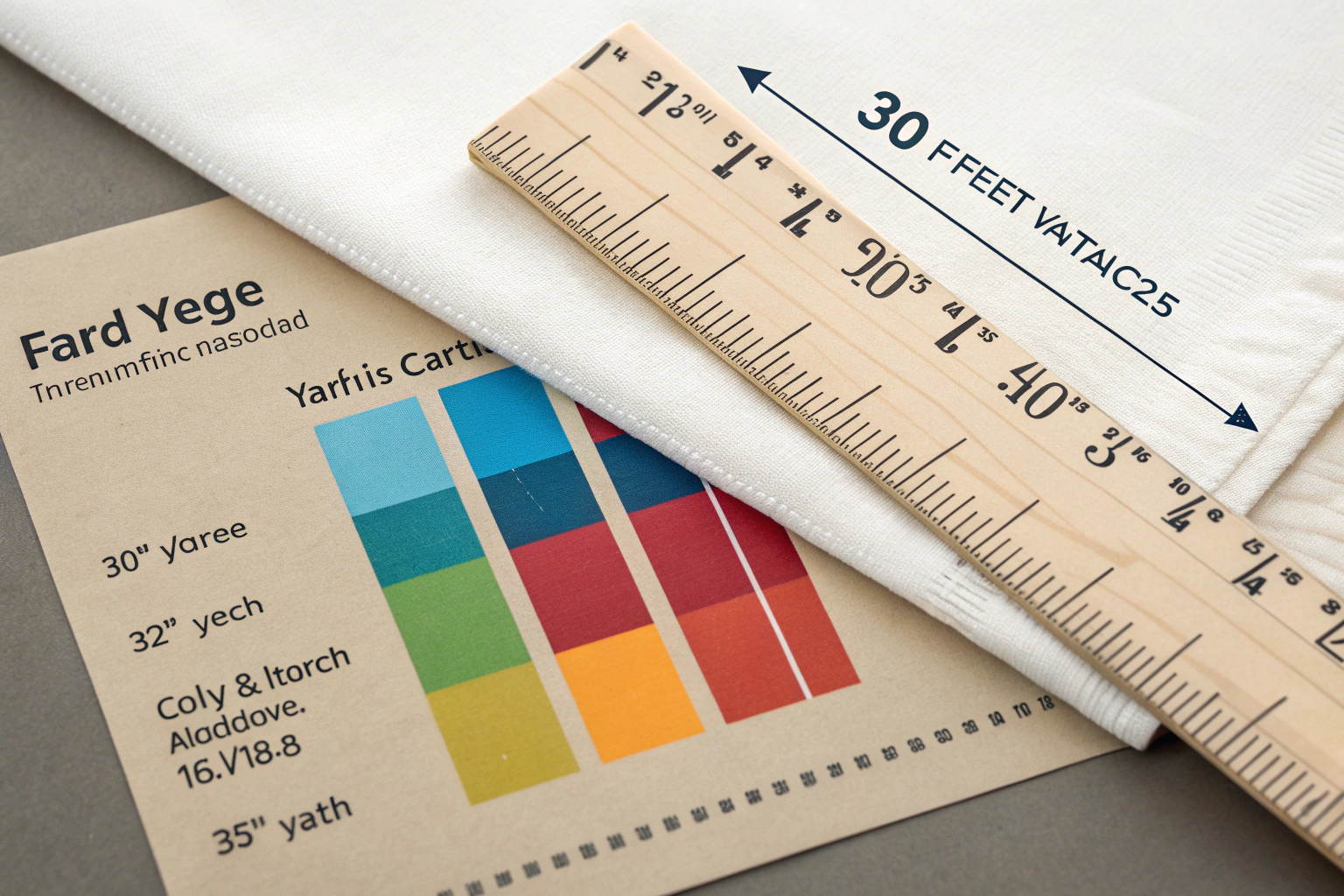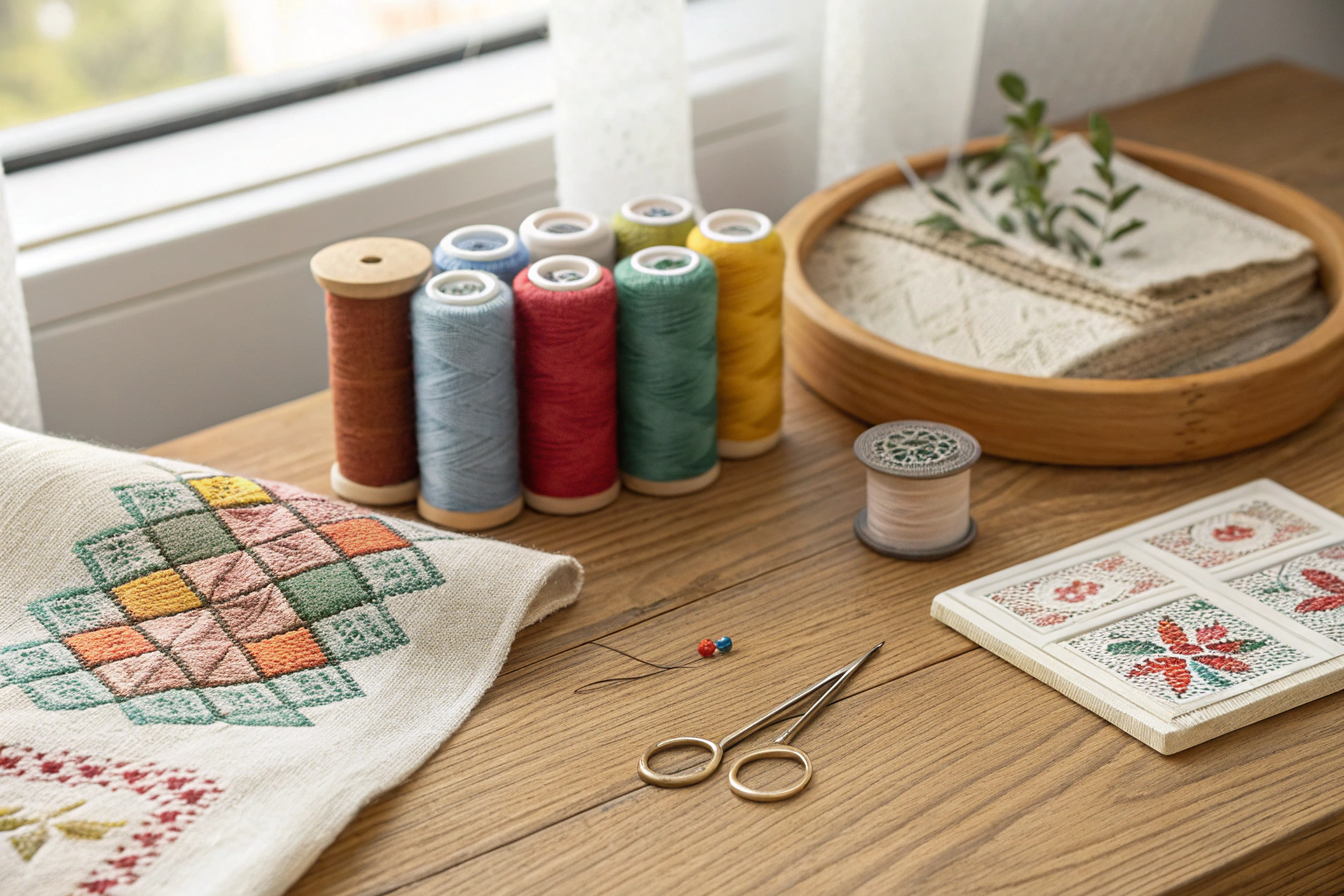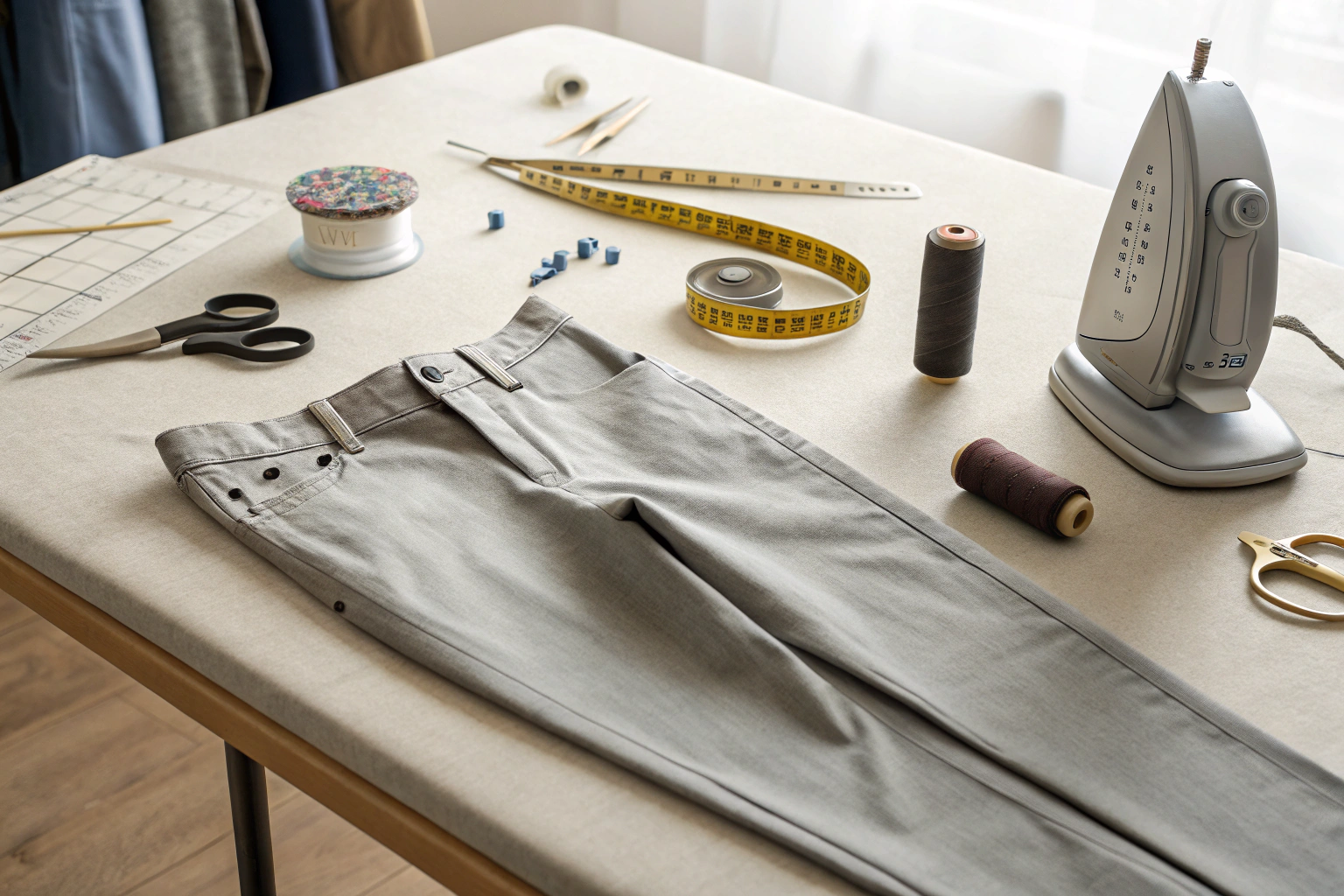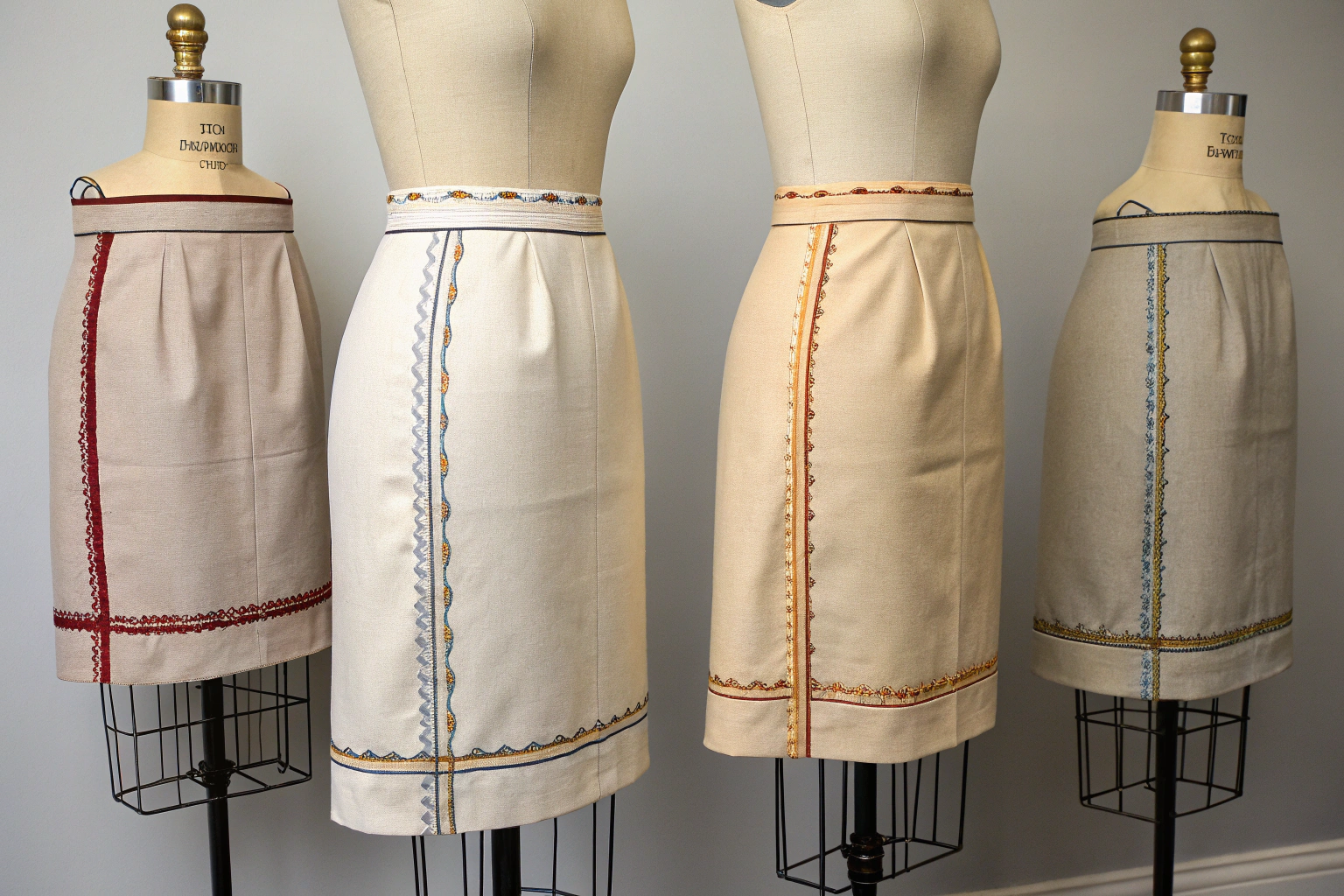A yard of fabric is a standard unit of length measuring 36 inches (3 feet or about 91 centimeters). When you purchase fabric, it is cut to this length from a larger roll, known as a bolt. The critical detail is that the fabric’s width is not fixed; it varies depending on the material and manufacturer, commonly ranging from 35 to 60 inches. Understanding this distinction between fixed length and variable width is essential for buying the correct amount for a sewing or craft project.
Key Benefits at a Glance
- Cost Savings: Prevent overspending by accurately calculating the material you need, avoiding the purchase of excess fabric.
- Project Success: Ensure you have enough material to complete your project from start to finish without frustrating shortages.
- Simplified Planning: Confidently follow commercial sewing patterns or create your own project plans with reliable measurements.
- Waste Reduction: Minimize leftover scraps by purchasing fabric more precisely, leading to less material waste and a cleaner workspace.
- Efficient Layouts: Choose a fabric bolt with the ideal width for your pattern pieces, allowing for smarter layouts that maximize material usage.
Purpose of this guide
This guide is for home sewists, crafters, quilters, and anyone starting a project that requires fabric. It solves the common and costly problem of buying the wrong amount of material by explaining the relationship between a fabric’s length (the yard) and its variable width. You will learn not only the standard dimensions but also how to account for different bolt widths when following a pattern, tips for converting measurements for different projects, and common mistakes to avoid. Ultimately, this guide empowers you to shop for fabric confidently and execute your creative visions successfully.
Understanding Fabric Basics: What Exactly Is a Yard?
A yard of fabric is a fundamental measurement in the textile world that refers specifically to 36 inches or 3 feet in length. This standard measurement has been used in the fabric industry for centuries and remains consistent worldwide, providing a reliable unit for purchasing and calculating fabric needs.
When you hear someone say “a yard of fabric,” they’re referring exclusively to the length measurement – the distance from one cut edge to another along the fabric’s grain. This measurement runs parallel to the selvage (the finished edge of the fabric), which is the tightly woven border that prevents fraying.
The term “linear yard” is often used interchangeably with “yard” in fabric terminology. Both refer to the same 36-inch length measurement, regardless of the fabric’s width. This distinction is crucial because while the length remains constant, fabric width can vary dramatically depending on the type of material and its intended use.
Fabric stores measure and cut fabric using specialized cutting counters equipped with measuring rulers. When you request a yard of fabric, the store employee will measure 36 inches from the bolt and make a clean cut across the width of the fabric. This process ensures you receive exactly one linear yard of material.
“The simplest explanation is that a yard is the length of fabric equal to 36 inches, 3 feet, 0.9144 meters or 91.4 centimeters. Note that a yard of fabric refers to its length only. The width can vary from 36 inches (0.90m) to 60 inches (1.5m).”
— Treasurie, March 2024
Source link
| Unit | Measurement | Equivalent |
|---|---|---|
| 1 Yard | 36 inches | 3 feet |
| 1 Yard | 0.9144 meters | 91.44 centimeters |
How Fabric Width Varies and Why It Matters
Understanding fabric width is essential for accurate project planning because it directly affects how much fabric you’ll actually need. While a yard of fabric is always 36 inches long, the width can vary significantly depending on the type of fabric and its intended use.
Fabric width is measured selvage to selvage – from one finished edge to the other. This measurement determines how much material you have to work with across the width of your fabric. The relationship between length and width is crucial for calculating the total area of fabric available for your project.
From my experience working with various fabric types, wider isn’t always better. The ideal width depends entirely on your project requirements. For example, if you’re making a narrow table runner, a 44-inch wide fabric might provide enough width for multiple runners from a single yard, while a 108-inch wide fabric would be wasteful for such a project.
- Quilting cotton: 42″-44″ wide
- Apparel fabrics: 36″-60″ wide
- Home décor fabrics: 54″-60″ wide
- Upholstery fabrics: 54″-60″ wide
- Wide backing fabrics: 90″-108″ wide
Understanding these width variations helps you make informed decisions when selecting fabrics for your projects. I always consider the fabric width before purchasing, especially for large projects where the width could significantly impact the total yardage needed.
What Is a Bolt of Fabric?
A bolt of fabric is the large roll or rectangular piece of cardboard that fabric is wound around for storage and display in fabric stores. Bolts serve as both a storage method and a display system, allowing customers to see the fabric’s pattern and feel its texture while keeping the material organized and protected.
Most bolts contain between 40-100 yards of fabric, depending on the fabric weight and type. Heavier fabrics like canvas or denim typically have shorter bolt lengths, while lightweight cottons might have longer lengths on each bolt.
One important aspect to understand is how fabric is presented on bolts. Some fabrics are folded in half lengthwise before being wound onto the bolt, which means you’re only seeing half the true width when browsing. Other fabrics are rolled at their full width. This presentation method can sometimes conceal the actual usable width of the fabric.
When shopping at fabric stores, I’ve learned to identify whether fabric is folded on the bolt by looking for the fold line or asking store employees. This knowledge prevents surprises when the fabric is unfolded and reveals its true width, which might be different from what you observed on the bolt.
What Is the Selvage of Fabric?
The selvage (sometimes spelled “selvedge”) is the tightly woven edge that runs along the length of fabric, parallel to the 36-inch yard measurement. These edges are created during the weaving process and serve the important function of preventing the fabric from fraying or unraveling.
Selvages often contain valuable information including manufacturer’s logos, fabric line names, color registration marks, and sometimes care instructions. These details can be helpful for identifying the fabric later or matching it with other pieces from the same collection.
In my projects, I typically trim away selvages because they’re often more tightly woven than the rest of the fabric, which can cause puckering in finished items. However, some quilters incorporate selvages into their designs as a decorative element, and they can be useful for fabric identification and organization.
To identify selvage edges, look for the finished, non-fraying edge that runs the length of the fabric. Selvages are distinctly different from cut edges, which may fray and show loose threads. Understanding where selvages are located is critical for measuring fabric correctly and planning your cuts.
Fabric Measurement Conversions Made Simple
Working with fabric measurements requires understanding various unit conversions, especially when following patterns from different countries or working with international suppliers. Having these conversions readily available saves time and prevents costly calculation errors that could result in purchasing insufficient fabric.
These conversion tables have proven invaluable in my work, particularly when adapting patterns that use metric measurements or when working with clients who prefer different measurement systems. Understanding these relationships helps ensure accuracy in project planning and fabric purchasing.
| From | To | Conversion |
|---|---|---|
| 1 Yard | Inches | 36 inches |
| 1 Yard | Feet | 3 feet |
| 1 Yard | Meters | 0.9144 meters |
| 1 Yard | Centimeters | 91.44 cm |
- To convert yards to inches: multiply by 36
- To convert yards to feet: multiply by 3
- To convert yards to meters: multiply by 0.9144
- To convert yards to centimeters: multiply by 91.44
Fabric Yardage Conversion Table for Common Fractions
Understanding fractional yards is essential because fabric stores commonly sell fabric in 1/8 yard increments. Knowing these conversions helps you visualize exactly how much fabric you’re purchasing and ensures you buy the correct amount for your project needs.
These fractional conversions are particularly useful when following patterns that specify fabric requirements in fractions rather than whole yards. Having these measurements memorized or easily accessible can speed up your shopping process and help you make quick decisions at the fabric store.
| Fraction of Yard | Inches | Centimeters |
|---|---|---|
| 1/8 yard | 4.5 inches | 11.4 cm |
| 1/4 yard | 9 inches | 22.9 cm |
| 3/8 yard | 13.5 inches | 34.3 cm |
| 1/2 yard | 18 inches | 45.7 cm |
| 5/8 yard | 22.5 inches | 57.2 cm |
| 3/4 yard | 27 inches | 68.6 cm |
| 7/8 yard | 31.5 inches | 80.0 cm |
Understanding Fabric by the Bolt vs. by the Yard
When purchasing fabric, you have two primary options: buying by the yard for individual projects or purchasing by the bolt for larger quantities. Understanding the difference between these purchasing methods can help you make cost-effective decisions, especially for extensive projects or business purposes.
Buying by the bolt typically offers significant cost savings for large projects. Most fabric bolts contain 40-100 yards of material, and retailers often provide wholesale pricing when you purchase the entire bolt. This approach makes sense for projects like making multiple quilts, outfitting a large event, or when starting a sewing business.
However, purchasing by the yard remains the most practical choice for most home sewers and crafters. This method allows you to buy exactly what you need without committing to large quantities or substantial financial investment. It also enables you to test fabrics before committing to larger purchases.
I once saved over 40% on fabric costs for a large curtain project by purchasing three full bolts instead of buying individual yardage. The project required 85 yards total, and the bolt pricing made the investment worthwhile, even with some leftover fabric that I later used for smaller coordinating projects.
How Fabric Width Affects Your Project Planning
Understanding how fabric width impacts your project planning is crucial for accurate yardage calculations and efficient material usage. The width of your chosen fabric directly determines how many pattern pieces you can fit across the fabric and, consequently, how much length you’ll need to purchase.
Project planning should always begin with understanding both the width available in your chosen fabric and the width requirements of your pattern pieces. This relationship determines the most efficient layout and helps prevent purchasing too much or too little fabric.
“A yard of 60-inch wide fabric gives you 36 x 60 inches of material. A yard of 44-inch wide fabric gives you 36 x 44 inches of material. That’s equivalent to 15 square feet for 60-inch wide fabric.”
— IceFabrics, January 2025
Source link
- Determine the total area needed for your project
- Consider the fabric width available
- Account for pattern direction and matching
- Calculate the length needed based on width
- Add extra for mistakes and shrinkage
The same project can require dramatically different yardage depending on fabric width. For example, a tablecloth measuring 60 inches wide would require exactly one yard of 60-inch fabric, but would need piecing or a different approach with 44-inch fabric, potentially requiring more yardage and creating visible seams.
The Math Behind Fabric Calculations
Accurate fabric calculations rely on understanding the relationship between area, length, and width. These mathematical formulas provide the foundation for precise fabric purchasing and efficient project planning.
The basic area calculation forms the cornerstone of all fabric math: Length × Width = Area. This simple formula helps you determine exactly how much fabric surface area you have available and how much you need for your project.
- Basic area calculation: Length × Width = Area
- Converting square inches to square yards: Square inches ÷ 1,296 = Square yards
- Calculating linear yards needed: Area needed ÷ Fabric width = Linear yards required
For example, if you need to create a 45-inch by 72-inch tablecloth, you need 3,240 square inches of fabric. With 44-inch wide fabric, you would divide 3,240 by 44, requiring approximately 73.6 inches or about 2.1 yards of fabric length. However, with 60-inch wide fabric, you would only need 54 inches or 1.5 yards.
Understanding these calculations has saved me from numerous purchasing mistakes over the years. I once calculated fabric needs for a large wall hanging project and discovered that switching from 44-inch to 60-inch wide fabric would save me three full yards while eliminating the need for piecing.
Calculating Fabric for Specific Projects
Applying fabric measurement principles to real projects demonstrates how these calculations work in practice. Each project type has unique considerations that affect the final fabric requirements.
For a basic shirt, you need to consider the pattern layout, fabric width, and any directional elements. A typical shirt pattern designed for 44-inch fabric might require 2.5 yards, but the same pattern on 60-inch fabric might only need 1.75 yards due to more efficient piece arrangement.
Window curtains present different challenges, as the fabric width often determines the number of panels needed. For a 72-inch wide window with full coverage, you might need three panels of 44-inch fabric but only two panels of 60-inch fabric, significantly affecting your yardage calculations.
| Project Type | 44″ Wide Fabric | 60″ Wide Fabric |
|---|---|---|
| Basic Shirt | 2.5 yards | 1.75 yards |
| Simple Quilt (Twin) | 8-10 yards | 6-7 yards |
| Curtain Panel | 2-3 yards each | 2-3 yards each |
| Chair Reupholstery | 1.5-2 yards | 1-1.5 yards |
Common Fabric Width Standards by Type
Different fabric types are manufactured in specific width standards based on their intended use, manufacturing processes, and historical conventions. Understanding these standards helps you plan projects more effectively and set realistic expectations when shopping for materials.
Quilting cotton consistently comes in 42-44 inch widths, with 44 inches being the most common standard. This width evolved from historical loom limitations and has remained consistent because it works well for most quilting and general sewing applications.
Apparel fabrics show the most variation in width standards, ranging from 36 inches for some specialty fabrics to 60 inches for many modern knits and wovens. The width often relates to the fabric’s intended use – narrower widths for trim applications and wider widths for garment construction.
| Fabric Type | Typical Width Range | Most Common Width |
|---|---|---|
| Quilting Cotton | 42″-45″ | 44″ |
| Apparel Fabric | 36″-60″ | 45″ or 60″ |
| Home Décor | 54″-60″ | 54″ |
| Upholstery | 54″-60″ | 54″ |
| Wide Backing | 90″-108″ | 108″ |
How Fabric is Cut and Measured in Stores
Fabric stores use standardized methods for measuring and cutting fabric to ensure accuracy and consistency. Understanding this process helps you know what to expect when purchasing fabric and can help you verify that you’re receiving the correct amount.
Most fabric stores use cutting counters equipped with measuring rulers or tape measures marked at regular intervals. These tools allow employees to measure fabric accurately from the bolt. The measuring process typically involves unrolling fabric from the bolt and measuring along the length to reach the desired yardage.
Different cutting methods are employed depending on the fabric type. Sharp scissors provide clean cuts for most fabrics, while some woven fabrics can be torn or ripped along the grain line for perfectly straight cuts. Store employees are trained to choose the appropriate cutting method for each fabric type.
Many fabric stores have minimum cut requirements, typically 1/8 yard or 1/4 yard, to make the cutting process efficient and economical. Some specialty or expensive fabrics might have higher minimum cuts. It’s always wise to verify minimum requirements before planning your purchase.
What is the Usable Size of Cut Fabric?
The actual usable fabric you receive may be less than the measured yard due to several factors that occur after cutting. Understanding these reductions helps you plan more accurately and avoid shortages in your projects.
Edge straightening often requires trimming small amounts from cut edges to ensure they’re perfectly perpendicular to the selvages. This process can remove 1/4 to 1/2 inch from each cut edge, effectively reducing your usable length.
Pre-washing shrinkage varies by fabric type but commonly reduces fabric dimensions by 2-5%. Natural fibers like cotton and linen typically shrink more than synthetic materials. Planning for this shrinkage prevents project disappointments and ensures adequate fabric availability.
| Fabric Type | Typical Shrinkage | Recommended Extra |
|---|---|---|
| Cotton | 3-5% | 10% |
| Linen | 4-6% | 10% |
| Polyester | 1-2% | 5% |
| Wool | 2-4% | 8% |
For more details about standard measurements, see the yard overview or review the CDC fabric measurement guide.
Real-World Application: Calculating Fabric for Specific Projects
Applying fabric measurement knowledge to actual projects demonstrates how these principles work in practice. Each project type presents unique challenges and considerations that affect fabric calculations and purchasing decisions.
Pattern layout efficiency plays a crucial role in determining fabric requirements. Understanding how to arrange pattern pieces optimally can significantly reduce waste and save money, especially on expensive fabrics. This skill improves with experience and careful attention to grain lines and pattern matching requirements.
- Basic shirt or blouse calculation: Measure pattern pieces, account for seam allowances, consider fabric width and grain direction, add extra for adjustments
- Curtains for standard window: Calculate finished size plus hems, determine number of panels based on fabric width, account for pattern repeats if applicable
- Simple quilt project: Calculate total square footage needed, consider backing and batting requirements, plan for binding and borders
- Chair reupholstery: Measure all surfaces to be covered, account for tufting or pleating, add extra for pattern matching and tucking allowances
For a recent dining room chair reupholstery project, I calculated exactly 1.25 yards needed for the seat and back in 54-inch upholstery fabric. However, the fabric had a large floral pattern with a 27-inch repeat, requiring me to purchase 2 yards to ensure proper pattern placement and matching across both pieces.
Special Considerations for Directional and Patterned Fabrics
Directional fabrics and those with large pattern repeats require additional yardage calculations beyond basic area measurements. These fabrics demand careful planning to ensure pattern elements face the correct direction and align properly across seams.
Napped fabrics like corduroy or velvet must have all pattern pieces cut in the same direction to avoid color variation in the finished project. This requirement often increases fabric needs by 25-50% compared to non-directional fabrics.
Pattern matching at seams requires additional fabric to ensure design elements align correctly. Large patterns with significant repeats can add substantial yardage requirements, sometimes doubling the basic calculation for complex projects.
| Pattern Repeat Size | Additional Yardage | Typical Application |
|---|---|---|
| Small (under 6″) | 10-15% | Small florals, geometrics |
| Medium (6″-12″) | 15-25% | Medium florals, plaids |
| Large (12″-24″) | 25-50% | Large florals, damasks |
| Extra Large (over 24″) | 50-100% | Oversized patterns, large stripes |
I once worked with a fabric featuring a 36-inch pattern repeat for a sofa reupholstering project. The basic calculation suggested 8 yards would be sufficient, but the pattern matching requirements actually required 14 yards to ensure all cushions and sections aligned properly.
Expert Tips: Getting the Most from Your Fabric Yardage
Maximizing fabric efficiency requires strategic planning and creative thinking. These professional techniques can help you reduce waste, save money, and make the most of expensive or limited fabrics.
Layout planning before purchasing fabric can reveal opportunities for more efficient cutting. I always create a scaled layout drawing when working with expensive fabrics, which has prevented countless purchasing mistakes and helped optimize material usage.
- Always prewash fabric before calculating final needs to account for shrinkage accurately
- Create a cutting layout before purchasing fabric to verify your calculations and identify potential efficiencies
- Consider piecing non-visible sections from scraps such as pocket linings or interfacing pieces
- Buy extra for pattern matching but be strategic – calculate exactly what you need rather than guessing
- Look for wider fabrics for large projects to reduce seams and required yardage
- Plan coordinating projects to use leftover fabric efficiently
- Save selvages for testing dyes, pressing techniques, or interfacing compatibility
One of my most successful fabric efficiency projects involved a client’s living room makeover where careful planning allowed us to make curtains, throw pillows, and a table runner from what initially seemed like barely enough fabric. Strategic pattern placement and creative piecing techniques maximized every inch of the expensive designer fabric.
Frequently Asked Questions About Fabric Measurements
Understanding fabric measurements often raises questions that go beyond basic definitions. These common inquiries reflect real-world shopping and project planning situations that many sewers encounter.
- Is a yard of fabric always the same size? Yes in length (always 36 inches), but no in width, which varies by fabric type
- How much extra fabric should I buy for pattern matching? Depends on pattern repeat size – typically 10-50% additional depending on the repeat
- What does ‘WOF’ mean on a pattern? Width of Fabric – referring to the measurement from selvage to selvage
- Why do some fabrics come in different widths? Manufacturing processes, intended uses, and historical loom limitations determine standard widths
- How do fabric stores measure yards? Using measuring rulers or tape measures on cutting counters, measuring along the length of fabric
- Can I return unused fabric? Policies vary by store, but most require fabric to be uncut with original edges intact
- What’s the difference between linear yards and square yards? Linear yards measure length only; square yards measure area (length × width)
Quick Reference: A yard of fabric = 36 inches long, width varies by type, most common widths are 44″, 54″, and 60″, always account for shrinkage and pattern matching when calculating needs.
Conclusion: Confident Fabric Purchasing Starts with Understanding Measurements
Mastering fabric measurements transforms your approach to sewing and crafting projects, enabling confident purchasing decisions and efficient material usage. Understanding that a yard equals 36 inches in length while width varies by fabric type forms the foundation for all fabric calculations.
The relationship between fabric width and project requirements determines your final yardage needs more than any other factor. Whether you’re working with 44-inch quilting cotton or 108-inch wide backing fabric, understanding how width affects your calculations prevents purchasing mistakes and reduces waste.
These measurement principles have enhanced my project success rate significantly over the years. From calculating fabric for complex garments to planning large home décor projects, understanding measurements ensures adequate materials while minimizing excess purchases. The time invested in learning these fundamentals pays dividends in every subsequent project.
Apply this knowledge to your next fabric purchase with confidence. Start with accurate measurements, consider your specific project needs, and remember that understanding fabric dimensions is a skill that improves with practice. Each project offers opportunities to refine your calculation abilities and develop more efficient cutting layouts.
Now that you understand how much fabric you need, it’s time to cut with precision. Use the right scissors for clean edges that won’t fray: Best Scissors for Cutting Fabric.
For accurate results, always prewash natural fabrics before cutting. This prevents shrinkage after your project is complete. Learn why this step is essential: Turn Prewash Into the Essential Laundry Step You Never Skip.
To ensure your machine handles these precisely cut pieces perfectly, start with proper setup: Set Up Sewing Machine.
Consistent thread tension ensures your seams lie flat and don’t pucker. Apply these skills to your new project: Thread Tension Guide.
For garment repairs like hemming jeans or sewing on patches, knowing exactly how much fabric you need saves time and money. Apply your calculations here: How to Hem Jeans and How to Sew on a Patch.
Frequently Asked Questions
A yard of fabric is typically 36 inches long, with the width varying depending on the type of material, often ranging from 45 to 60 inches. This measurement is crucial when planning projects like sewing men’s clothing, where understanding how to measure waist for men ensures you buy enough fabric without excess waste. Consider factors like thread count and weave to determine the fabric’s suitability for your needs.
The width of a yard of fabric usually falls between 45 and 60 inches, though some specialty fabrics can be as narrow as 36 inches or as wide as 108 inches. When using a sewing machine for projects involving men’s apparel, knowing how to measure waist for men helps calculate the required width to avoid seams in awkward places. Always check the weave and dye consistency across the width for quality assurance.
There are 3 feet in a yard of fabric, as one yard equals 36 inches or 3 linear feet. This standard measurement is essential for accurate cutting, especially in sewing tasks where precision matters, like determining fabric for waistbands in men’s garments. Factor in thread count to ensure the fabric holds up well during use.
A linear yard measures length only, typically 36 inches long by the fabric’s width, while a square yard covers 9 square feet, accounting for both length and width in area. This distinction is important when calculating material for patterns, such as those requiring knowledge of how to measure waist for men to estimate coverage. Consider the fabric’s weave when deciding between measurements for efficient project planning.
To measure a yard of fabric, use a measuring tape or yardstick to mark 36 inches along the length from the cut edge, ensuring it’s straight and aligned with the selvedge. This technique is handy for home sewing with a sewing machine, particularly when preparing pieces for men’s clothing and applying tips on how to measure waist for men accurately. Check for even dye distribution to maintain consistency in your measurements.
